NRAO eNews
Volume Vol#, Issue Iss#
Day# Month# Year#
NRAO eNews
Volume Vol#, Issue Iss# • Day# Month# Year#

Upcoming Events

Community Webinar Series: (Advanced) Synthesis Imaging with CASA
Mar 24, 2022 | Virtual

18th Synthesis Imaging Workshop
May 18 - 25, 2022 | Virtual

Computational Astrophysics in the ngVLA Era: Synergistic Simulations, Theory, and Observations
Jun 7 - 9, 2022 | New York, NY

The VLA Sky Survey in the Multiwavelength Spotlight
Sep 7 - 9, 2022 | Socorro, NM
2022 Jansky Fellowships Awarded
The National Radio Astronomy Observatory (NRAO) Jansky Fellowship program provides outstanding opportunities for research in astronomy. Jansky Fellows formulate and carry out investigations either independently or in collaboration with others within the wide framework of interests of the Observatory. The program is open each fall to candidates with interest in radio astronomy techniques, instrumentation, computation, and theory. Multi-wavelength projects leading to a synergy with NRAO instruments are encouraged. We are pleased to announce that four new Jansky Fellows will be joining NRAO in fall 2022.
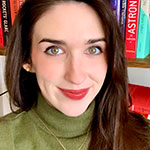
Rebecca Charbonneau earned her Ph.D. in History and Philosophy of Science from the University of Cambridge in 2021. Her dissertation focused on the history of radio astronomy and examined the challenges and benefits of international scientific collaboration during the Cold War period. She subsequently worked as the historian-in-residence at Harvard-Smithsonian Center for Astrophysics, during which time she led a project on preserving indigenous astronomical heritage. As a Jansky Fellow, her research program will make use of NRAO's historical archives and will focus on the history of international cooperation within radio astronomy.
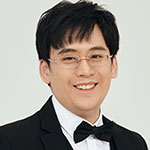
Tao-Chung Ching performed his Ph.D. study at the National Tsing-Hua University, Taiwan, and CfA under the supervision of Shih-Ping Lai and Qizhou Zhang. He later became a Five-hundred-meter Aperture Spherical radio Telescope (FAST) fellow at the National Astronomical Observatory of China working with Di Li. His research interests are interstellar magnetic fields and star formation through observational astronomy from submillimeter to radio wavelengths. Using FAST, Tao-Chung has obtained the first Zeeman detection of the HI Narrow Self-Absorption (HINSA) feature. As a Jansky Fellow at NRAO in Socorro, he will use the Very Large Array to explore HINSA as a systematic Zeeman probe, measuring magnetic field strengths of star-forming regions at high angular resolutions.
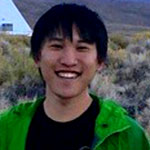
Dillon Dong completed his Ph.D. in 2022 at Caltech with Gregg Hallinan. Dillon is broadly interested in astronomical objects that evolve over human timescales, and how they interact with their local and large-scale surroundings. He uses a combination of multi-wavelength observations and order-of-magnitude theory to characterize variable and transient sources that he identified in the Very Large Array Sky Survey (VLASS). His current projects involve using supernovae as probes of pre-explosion eruptive mass loss, statistical characterization of black hole and stellar flares, and identifying radio transients with unusual spectral properties. As a Jansky Fellow at NRAO in Socorro, he will continue his study of VLASS transients and variables, with a focus on luminous, extragalactic radio transients. He will also continue his development of flexible tools to automate the detection of transients and variables in future VLA observations.
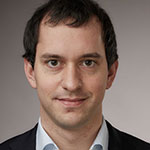
Michael Rugel investigates the multiphase interstellar medium (ISM) with surveys of the Milky Way at radio wavelengths. His research focuses on the formation of molecular clouds, as well as feedback in them with studies of tracers of atomic, molecular, and ionized gas. As a Jansky Fellow at the Center for Astrophysics–Harvard & Smithsonian and at NRAO Socorro, he will expand his research on star formation, structure, and evolution of the ISM with the THOR-GC survey, an extension of The HI, OH, Recombination Line survey of the Milky Way (THOR) to the Galactic Center, and the Bar and Spiral Structure Legacy survey (BeSSeL) extension to the southern Milky Way.
ALMA Ambassadors Proposal Preparation Events
In advance of the Atacama Large Millimeter/submillimeter Array (ALMA) Cycle 9 Call for Proposals deadline, the North American ALMA Science Center (NAASC), along with current ALMA Ambassadors, have organized a series of ALMA proposal preparation workshops from 28 March–8 April 2022. The goal of these events is to provide users with the knowledge they need to carry out cutting-edge scientific research using the ALMA facilities. We are particularly interested in reaching new users, so no experience with radio astronomy is required to participate!
These ALMA talks are hosted by experienced postdocs and graduate students as part of the ALMA Ambassadors program. Registration for these events is free. The workshops are designed to assist you in proposal preparation and observation planning for ALMA Cycle 9, and may include talks on the following topics:
- ALMA Basics and Cycle 9 Capabilities
- Radio Interferometry Basics
- Cycle 9 Proposal Preparation and the Proposal Review Process
- Introduction to the ALMA Observing Tool
- ALMA Data Products, Archive Use, and Notes on the Pipeline Weblog
- Common Astronomy Software Applications (CASA) Simulations
- Science-ready Data Products
- Imaging with CASA
Information on the locations and dates for these workshops is available on the NAASC Community Events webpage and in the table below.
| Ambassador | Location | Date |
|---|---|---|
| Wren Suess | Stanford University | 28 March |
| Nathan Roth | University of Maryland | 29 March |
| Hansung Gim | Montana State University | 29 March |
| Cheng-Han Hsieh | Yale University | 30 March |
| Tarraneh Eftekhari | Northwestern University | 1 April |
| Hansung Gim | University of Alabama | 2 April |
| Allison Towner | University of Florida | 5, 7, 8 April |
| Fengwu Sun | University of Arizona | 8 April |
The ALMA Ambassadors will also host several webinars for people unable to attend one of the workshops. The talks, dates, and registration links for the webinars are listed below. Webinars are planned in both English and Spanish.
| Title | Date |
|---|---|
| ALMA Basics and Cycle 9 Capabilities | 30 March @ 4pm ET |
| Cycle 9 Proposal Preparation & the Proposal Review Process | 31 March @ Noon ET |
| ALMA Basics and Cycle 9 Capabilities | 5 April @ 2pm ET |
| Cycle 9 Proposal Preparation & the Proposal Review Process | 5 April @ 4pm ET |
| Fundamentos de ALMA y Capacidades del Ciclo 9 / ALMA Basics and Cycle 9 Capabilities (in Spanish) | 6 April @ 12pm ET |
| Planificación de propuestas y proceso de revisión de propuestas / Proposal Planning and the Proposal Review Process (in Spanish) | 7 April @ 12pm ET |
Later in the year, the ALMA Ambassadors will run another series of community events focused on the processing and analysis of ALMA data. Those events will be announced in a future eNews, so stay tuned.
ALMA Program News
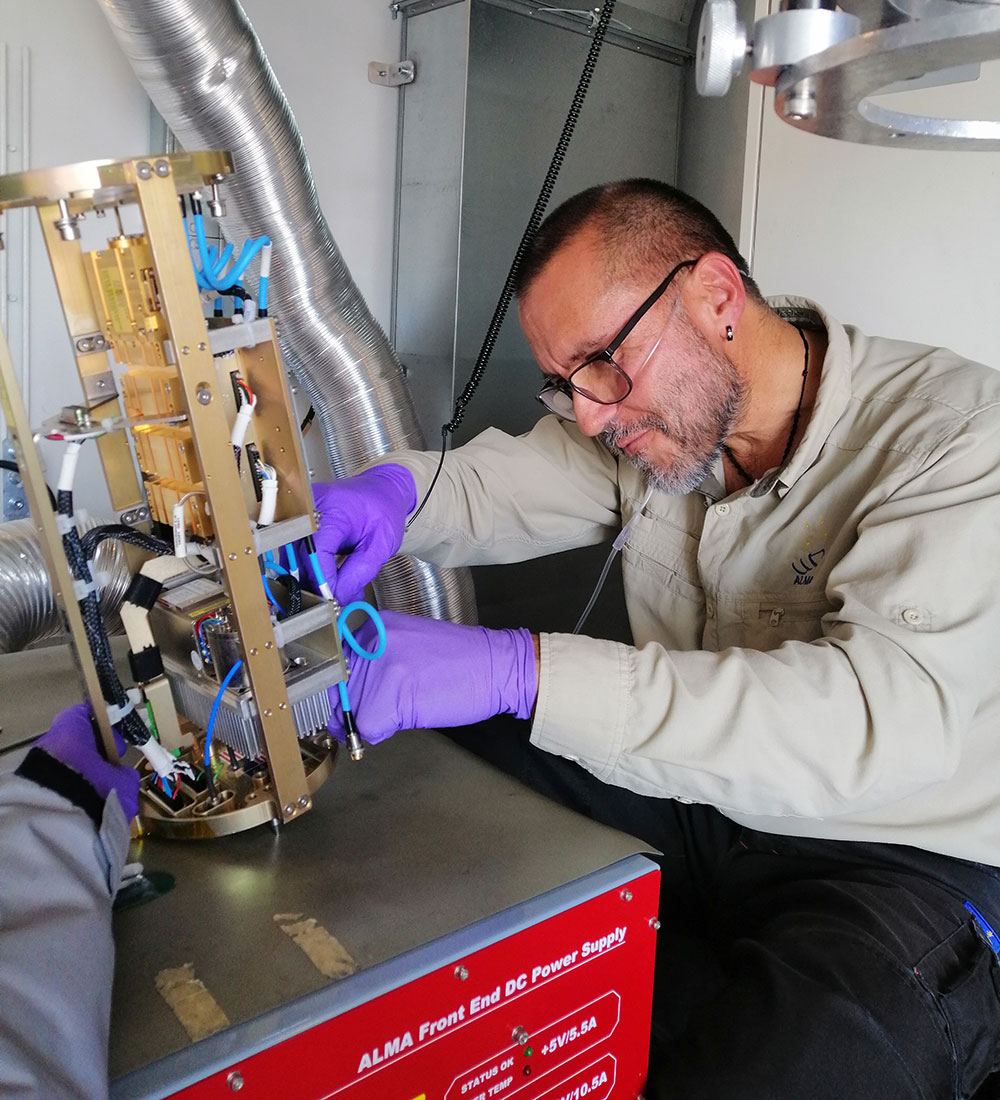
Pablo Carrillo, Daniel Fernandez
ALMA receiver components need periodic adjustment and maintenance. It may be worthwhile to make the repairs at the Array Operations Site at 5000 meters altitude though care must be taken to avoid electrostatic discharges in the thin dry air, and oxygen is needed to ensure an efficient repair. Here Pablo Carrillo works on a Band 7 Warm Cartridge replacement in antenna DA52.
[click to enlarge]
Director's Term Extended
The ALMA Board has unanimously voted to offer Dr. Sean Dougherty a five-year extension to his appointment as ALMA Director from February 2023 to February 2028, an offer which he has gladly accepted.
ALMA Observations
ALMA continues Cycle 8 observations, now in the compact configuration after successful conclusion of the austral summer maintenance period.
ALMA Cycle 9 will start in October 2022 and will span 12 months. The Joint ALMA Observatory (JAO) anticipates having 4300 hours for approved science observations on the 12-m Array and 4300 hours on the Atacama Compact Array (ACA), also known as the Morita Array. Projects with observations in the highest-frequency Bands 8, 9, and 10 are strongly encouraged. A pre-announcement for the Cycle 9 Call for ALMA observing proposals, expected to be issued 24 March, was issued 15 December 2021. Planned new ALMA capabilities were announced therein, and at the ALMA science website.
ALMA Status and Wideband Sensitivity Upgrade Progress
The North American Science Center held a Webinar at 3:00 pm EDT, 16 March in which speakers described ALMA news, capabilities, and expectations for ALMA performance and science in the next few years, and plans for its upgrade in the 2030 time frame. In that period, ALMA will complete its frequency coverage of the millimeter window. Band 1 (8.6-6.0mm; 35-50 GHz), is being installed on the array now. Band 2 (4.5-3.3mm; 67-90 GHz) will follow, completing installation of the baseline ten bands. A recording of the webinar will be available soon.
A Band 6 upgrade, a part of the ambitious ALMA2030 Wideband Sensitivity Upgrade, is in its early stages. A report on recent studies which led to the development of the upgrade is available. This upgrade will improve ALMA's bandwidth and spectral line sensitivity in this most productive of bands. Eventually, ALMA's bandwidth will be increased to simultaneously enhance its spectral range and continuum sensitivity, even as its line sensitivity is increased via receiver upgrades, an upgraded correlator, and improvements of the systems connecting them. Higher resolution imaging is being explored, both on ALMA's 5000m exceptional site and as part of extremely long baseline imaging arrays.
ALMA Science Sustainability
A Call for Proposals for ALMA Development Studies will be released in May 2022. The deadline for proposals will be in July 2022 for funding to run 1 Jan 2023 — 31 Dec 2023 — depending on the U.S. Federal budget process. We welcome any member from within the North America ALMA Development Partnership (U.S. or Canadian Institution) to submit a proposal to investigate a potential ALMA upgrade, particularly those which address goals of the ALMA2030 Development Plan (ALMA Memo 612) and the ALMA2030 Wideband Sensitivity Upgrade. When the call opens the materials will be linked from the NA ALMA Development Program website.
The VLA Sky Survey in the Multiwavelength Spotlight: Second Announcement
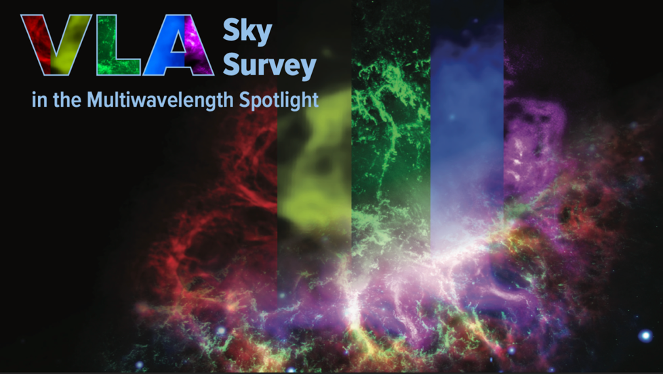
The NRAO is organizing the “Very Large Array Sky Survey in the Multiwavelength Spotlight” conference that will take place from 7-9 September 2022, in Socorro, New Mexico, USA as well as virtually! The hybrid format of this conference will allow participants to choose to attend either in-person or virtually.
The goal of this conference is to share a wide range of scientific perspectives, both on the discoveries enabled by the Very Large Array Sky Survey (VLASS) on its own, and on advances made possible through synergy with other datasets. Opportunities for multiwavelength VLASS synergy include radio/mm observatories and surveys (e.g., ALMA, LOFAR, ASKAP, MeerKAT, Apertif), optical/infrared imaging and spectroscopy (e.g., HST, Roman, Euclid, DESI, PFS, JWST), multi-epoch widefield surveys (e.g., SDSS, PanSTARRS, LSST, DES, ZTF), and the high-energy domain (e.g., Chandra, XMM-Newton, eROSITA).
Abstract submission is now open: Submit your abstract today! Contributed oral abstracts will be accepted until 1 June 2022, and poster abstracts will be accepted until 1 August 2022. We are soliciting abstracts for both oral and poster presentations related to the following key topics:
- Galaxies, SMBHs, AGN, and quasars
- Explosions, variables, and transients
- Star formation and the ISM
- Galactic radio sources
- Polarimetry and Magnetism
- Multiwavelength surveys and instruments
- Data products, archives, and tools
(*Broadening participation topics include student programs, mentoring, and outreach.)
Confirmed Invited Speakers: |
Key Important Dates: |
SOC: |
LOC: |
Questions? For additional conference details, please visit go.nrao.edu/vlass22 or contact the conference mailbox at vlass22@nrao.edu. Be sure to follow us on Twitter and join the conversation by using #VLASS22.
ngVLA Project News

ngVLA Community Studies Awards Announced
The NRAO supports an ngVLA Community Studies Program, allowing members of the scientific and engineering communities to help build a final concept for this flagship facility. Studies approved in the fifth round of the Program were recently announced. Since the Program's inception in 2016, 50+ studies have been approved.
VLA/VLBA to ngVLA Transition Advisory Group
The NRAO has begun the process of developing a plan to transition from the operation of the Very Large Array (VLA) and Very Long Baseline Array (VLBA) to the ngVLA. This activity will be led by the community-based VLA / VLBA to ngVLA Transition Advisory Group. Guided by the scientific opportunities planned for the coming decade, the Group will be charged to develop, quantitatively assess, and evaluate a finite number of possible VLA / VLBA to ngVLA transition options that can be prioritized on their scientific promise, cost, and technical/personnel impacts. To nominate yourself or someone else for Group membership, fill out the form by 18 March 2022. The Group's summary report is anticipated to be completed in early 2023.
Computational Astrophysics in the ngVLA Era: Synergistic Simulations, Theory, and Observations
This conference will be held 7-9 June 2022 at the Simons Foundation's Flatiron Institute in Manhattan, New York, USA. The in-person conference will bring together theoreticians, modelers, and observers to discuss the computational astrophysics and observational challenges for the next generation of observatories, focusing on the ngVLA. The participation of early career scientists is particularly encouraged. Abstracts for oral presentations are due 1 April 2022.
Decelerating Jets from X-ray Binaries
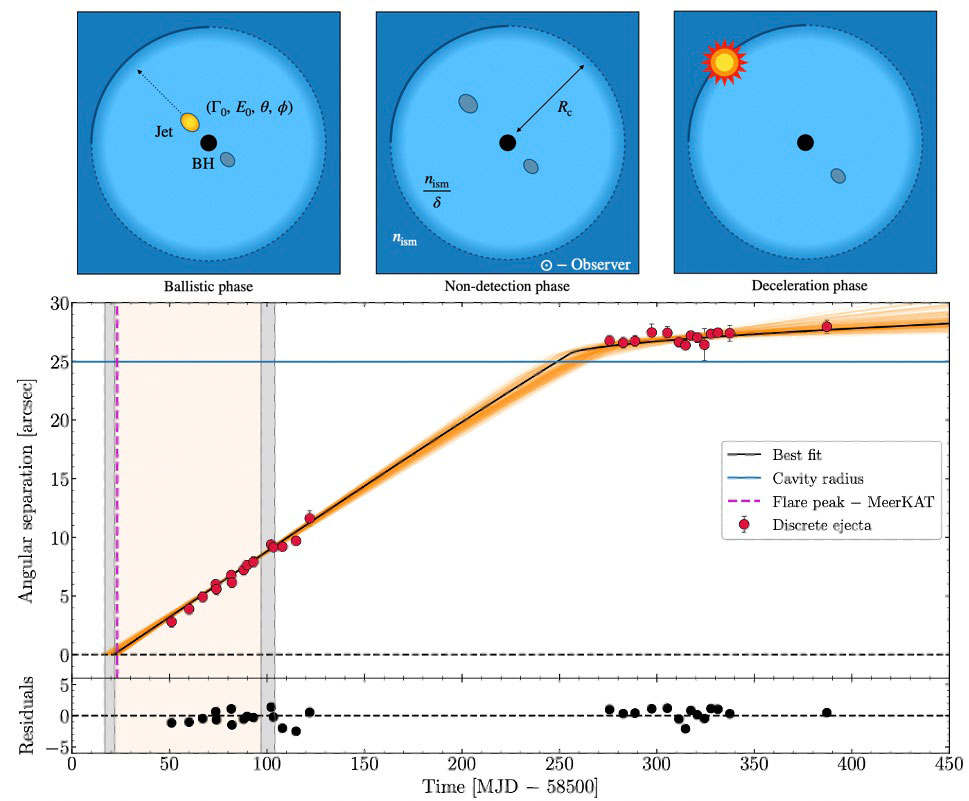
Tracking the motion of a discrete jet ejection launched by BHXB MAXI J1348-630. Top: Schematic of different phases of jet ejecta motion. Bottom: Best-fit external shock model over-plotted on positional data (Carotenuto et al. 2022).
[click to enlarge]
A key open question in high energy astrophysics is understanding how black holes act as powerful cosmic engines, gravitationally capturing material and expelling matter in the form of relativistic jets. Stellar-mass black holes in Galactic X-ray binaries (BHXBs) are ideal test-beds for jet phenomena, as they enter into bright outbursts on timescales of days to months, providing a real-time view of how these jets evolve and interact with their environment.
The most spectacular type of jets observed from BHXBs are discrete jet ejections, which take the form of bi-polar plasma clouds often found to travel at apparent superluminal speeds, similar to those observed in supermassive black hole systems. So far, direct imaging studies in the cm-regime have resolved and tracked jet ejecta motions in a handful of systems, over timescales from minutes to months (e.g., Mirabel & Rodriguez 1994; Corbel et al. 2005; Miller-Jones et al. 2019; Bright et al. 2020).
Usually only the first phase of the jet ejecta motion has been observed, wherein the ejecta are adiabatically expanding and travelling at near constant speeds. However, after this initial phase the ejecta can travel unseen for months to years, before being detected again at parsec scales. At this point, the interaction of the ejecta with the surrounding medium causes the jets to strongly decelerate and produce synchrotron radiation from in-situ particle acceleration, up to TeV energies (e.g., Corbel et al. 2002; Migliori, et al. 2017; Espinasse et al. 2020).
We recently tracked the motion of a jet ejection in the BHXB MAXI J1348-630 over its entire trajectory with MeerKAT and Australia Telescope Compact Array, spanning about 400 days (see figure; Carotenuto et al. 2022). This incredible observational coverage allowed us to model the complete jet motion with a physically motivated, dynamical external-shock model, rather than a traditional phenomenological kinematic model. We were thus able to precisely pinpoint the ejection time (essential to search for a unique observational signature associated with the ejection) and also constraint key jet properties (jet speed, energetics, composition, density and size of the jet-blown cavity in the surrounding medium).
Tracking the jet deceleration phase is key to improving our understanding of jet production, acceleration, and feedback on the surrounding environment. More observations of decelerating ejecta from BHXBs, including dense, uniform, and sensitive radio coverage, are required for these efforts. Our latest work has shown the value of the new generation of interferometers, such as MeerKAT, but the ngVLA will be even more transformative for this science. The ngVLA's higher resolution will allow us to track the full jet ejecta motion, from launching to deceleration, with a single facility. Its higher sensitivity will enable the detection of fainter systems, vastly increasing our sample of potential jets to observe. That higher sensitivity also improves the prospects of detecting fainter counter-jets travelling away from us, as well as multiple jet ejection episodes in the same system. Such added measurements could allow us to break degeneracies that exist in our modelling efforts.
Since 2015 the acronym ngVLA has appeared in 750+ publications indexed in the SAO/NASA Astrophysics Data System. This article continues a regular feature intended to showcase some of those publications. We are especially interested in showcasing work done by early-career researchers. The collection of showcase articles can be viewed online. Anyone wishing to volunteer to author a feature should contact Joan Wrobel.
NRDZ Project

NRAO-CDL
Conceptual Design of the ASMH device is underway under the direction of Central Development Laboratory (CDL) engineer Kevin Shoemaker. This illustration shows a possible housing for the ASMH device.
[click to enlarge]
You have probably heard of the National Radio Quiet Zone (NRQZ), the 13,000 square mile region in West Virginia and Virginia established in 1958 to protect radio astronomy in Green Bank, WV and other sensitive receivers in Sugar Grove, WV. The National Radio Dynamic Zone (NRDZ) is a new and different idea. As described by the National Science Foundation (NSF), “The long-term goal of the NSF-NRDZ is to provide enhanced spectrum usability and access for both passive and active users of the spectrum, piloting the technology in a few limited, yet diverse, geographic areas, to enable wider future deployments.”
As the active and passive communities discuss what precisely an NRDZ could be, we need to carefully listen to one another to understand how such a zone would potentially be used by various stakeholder communities. While communities and subcommunities have differing use cases, the unifying motivator for all stakeholders that has come through clearly in discussions and workshops is increased spectrum access. That is, passive users (radio astronomy and remote sensing) are developing receivers with ever wider bandwidths to increase sensitivity and reduce observing time, and active users are developing transmitters and receivers that require broader bandwidth for faster throughput of information for an increasing number of wireless-enabled systems. An NRDZ could be a test site for systems that allow for the testing of innovative spectrum sharing techniques that could be advantageous to all communities.
NRAO is contributing to this national, NSF-supported effort in three ways: (1) clarifying a stakeholder definition of an NRDZ and how it might function; (2) designing and building a high-sensitivity RFI monitoring prototype at the Central Development Laboratory (Advanced Spectrum Monitoring Hardware or ASMH); and (3) developing outreach materials and curricula for high school and college students and citizen scientists that address the electromagnetic spectrum and radio frequency interference.
The project is in its first year, and the NRDZ Project Team will continue to highlight developments in this project as it progresses. We plan to deliver the ASMH prototypes, the NRDZ concept definition, and the finalized curriculum by summer 2023. If you have questions or comments, please reach out to me at cdepree@nrao.edu.
The New NRAO Archive and Decommissioning the Legacy Archive
We are excited to announce the release of Archive version 4.1 on 28 February 2022. This release brings improved support for Very Long Baseline Array (VLBA) data sets (including respect for multiple correlation passes) as well as access to legacy Very Large Array (VLA) and VLBA data sets. With this release the new archive becomes the primary service for all NRAO science data products, and continues to provide access to Atacama Large Millimeter/submillimeter Array (ALMA) data products.
The legacy NRAO archive, which has served the community well for many years, will be retired on or about 2 May 2022. At that time, users will be redirected to the new archive to access their data. NRAO is continuing to develop the new archive, fixing bugs, and working to improve the user experience. Users who encounter difficulties accessing data, find possible bugs, or have feature requests for the new archive should contact the NRAO helpdesk.
2022 Jansky Lectureship – Call for Nominations
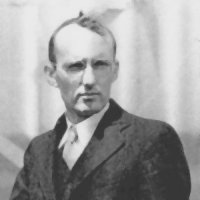
The Karl G. Jansky Lectureship is an honor established by the trustees of Associated Universities, Inc., to recognize outstanding contributions to the advancement of radio astronomy. First awarded in 1966, it is named in honor of the man who, in 1932, first detected radio waves from a cosmic source. Karl Jansky's discovery of radio waves from the central region of our Milky Way Galaxy started the science of radio astronomy.
The 2022 Jansky Lecturer will have made significant contributions related to radio astronomy, and will promote the appreciation of the science of radio astronomy through public lectures at the NRAO sites. A demonstrated ability to engage a wide audience will be a factor in determining the awardee. Visit the Jansky Lectureship website for a list of the previous recipients of this prestigious award. Additional information, including the nomination and selection process, is available online.
Nominations for the 2022 award should be concise (~1 page) and address both the nominee’s contribution to the advancement of radio astronomy and their potential to increase public appreciation through the Jansky Lecture.
Nominations should be sent to jburns@nrao.edu by 8 April 2022.
NRAO scientific staff will be given an opportunity to vote on nominations received and the results will be included in the recommendation to the NRAO Director.
Virtual VLA Tour: Women's History Month
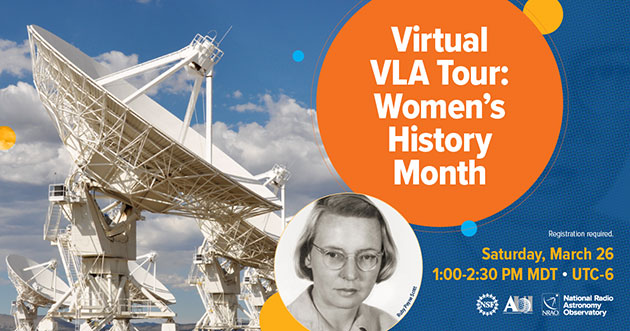
Ruby Payne-Scott, the first female radio astronomer, made essential contributions to the field of radio astronomy during her time at the Radiophysics Laboratory of the Australian government’s Commonwealth Scientific and Industrial Research Organisation (CSIRO). From working on radar during World War II to confirming that sunspots create intense radio bursts, Payne-Scott was instrumental in the birth of radio interferometry and her legacy remains an inspiration to women in radio astronomy today. Join us for a virtual tour of the VLA followed by conversation with Payne-Scott’s biographer and a panel of women currently working at NRAO.
Guest experts include:
- Miller Goss, NRAO Astronomer Emeritus, Author of “Making Waves: The Story of Ruby Payne-Scott”
- Sylvia Kowalski, NRAO VLA Operator
- Julia Blue Bird, NRAO Astronomer and Jansky Fellow
- Bade Uzgil, NRAO ngVLA Research Associate
This virtual tour will take place on Saturday, March 26, 2022, 1-2:30 PM MDT [Mountain Daylight Time, UTC/GMT -6].
This event will take place on Zoom. Registration is required.
From the Archives
Ellen Bouton

[click to enlarge]
About this month's photo: In March 1973, operations began with the fourth element of the Green Bank Interferometer, a remotely-located 45-foot antenna used to test atmospheric stability over baselines comparable to those that were planned for the Very Large Array. A 42-foot antenna had been used for the testing since 1967, but a better telescope was needed to pursue science at the desired baselines. The 45-foot enabled operation at high frequencies, supported observations at two frequencies simultaneously, and had an improved mount which allowed accurate pointing over a much greater part of the visible sky. This photo shows the 45-foot at Huntersville, with an inset of the dish assembly in October 1972.
From the Archives is an ongoing series illustrating NRAO and U.S. radio astronomy history via images selected from our collections of individuals' and institutional papers. If readers have images they believe would be of interest to the Archives, please contact Ellen Bouton.

